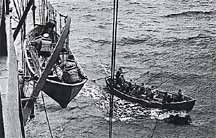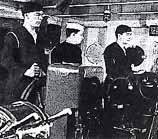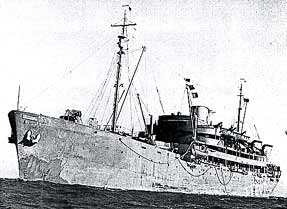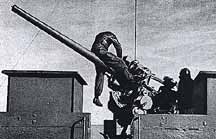Training Ship: Thousands of Apprentice Seamen Get a Real Look At What Life Aboard Ship is Really Like on One of Ten Training Ships Used by the Maritime Service
MAST Magazine, February 1944
'Bow lookout reporting, Sir! Submarine one point on the starboard bow."
The message crackles to the bridge. Terse, crisp commands are issued. General quarters is sounded. A few seconds of breathless, pell-mell confusion, and then a quiet, awful tenseness permeates the training ship.
'All's clear, secure." Like a huge sigh, the collective conversation and exclamations of the six hundred men arise. "One of ours. Whew, I thought that was the business, sure enough." One of ours. Maybe next time it would be the real thing. But they'd be ready. Trained and ready for any exigency that can, and all too often does, arise at sea.
At sea, men's lives, their ship and its precious cargo may depend upon the rapidity of an individual's response to emergency signals. The man must know where to go, what to do in the split second after the signal has sounded. If he acts quickly and intelligently, the individual seaman sometimes has it within his power to save the lives of his fellows, perhaps even his ship and its cargo.
There are two ways men can be taught to react correctly and quickly under conditions of extreme emergency. To live through such emergencies, or to train under conditions having a close degree of similarity to actual situations. Many, too many, of the men sailing our merchant ships learned these lessons of the sea the hard way, the empirical way. They've had ships blasted out from under them. They've heard the anguished cries of comrades floundering about in seas of burning oil. They've seen men drown for lack of ability or lack of knowledge of the fundamentals of safety seamanship. They know --- but they've learned the hard way.
Out at sea trainees get a good idea of what the signal,
"Abandon Ship!" means --- importance of speed and
obedience to commands in launching lifeboats
Safely away from the "sinking" ship in practice drill, boatload of
"survivors" sharpen rowing technique. Drills are taken seriously
An educational program has been set up which is turning out seamen trained and ready to take their places aboard ships of the fastest growing merchant fleet in the world. The U. S. Maritime Service is striving to develop trained and efficient citizen personnel for our Merchant Marine. The training program now includes a two to four weeks cruise for each seaman-in-training on one of the seven steamships and three sailing vessels operated by the Maritime Service is training ships. These vessels have a combined capacity for training 2,500 men each week.Regular Sea Duties
Thousands of seamen who are now sailing the seas in freighters and tankers had their first lessons in practical seamanship aboard these ships. They cruise offshore under actual sea conditions, getting a "feel" of their jobs that would be impossible on a training station, no matter how realistic the surroundings.
Trainees gaining valuable experience
as quartermasters on the wheel
Under the guidance of competent instructors, the trainees go about their daily duties knowing that in a few short weeks they'll be out in convoy under similar circumstances. That is sufficient to give them a serious attitude aboard, and they absorb all they can before the vessel docks to take on a new contingent.The average man who comes aboard a training ship after seven or eight weeks of basic training at a Maritime station has never been to sea. The training cruise gives him the confidence he would otherwise lack when he takes his first sea job.
On cruises the seamen stand regular watches, take over quartermaster duties, handle winches and cargo gear, cook meals and wait on table, soogee bulkheads, check engine room equipment, and man the guns. In short, they handle every job aboard. The trainees also find out what it's like to actually abandon ship and answer to fire and boat drills.
Training cruises usually last from two to four weeks. At the end of this time trainees await their calls to a shipping pool and are soon called to fill in positions aboard an outward bound ship.
USMSTS American Mariner
The setting for this story is the steamship American Mariner, newest ship of the training fleet. She was the first ship to be commissioned exclusively for the purpose of training men for active duty on merchant vessels of the United States. The keel was laid August 14, 1941 and she was launched less than five months later on December 30.
U.S. Maritime Service Training Ship American MarinerThe Mariner is the only one of six steamships operating as training ships that was designed and built solely for training purposes; she has the most modern fittings and equipment of all six. The overall length of the vessel is 441 feet, six inches. She has a beam of 56 feet, one inch and dead-weight tonnage of 4,635.5. Her complement consists of Captain, 24 officer personnel, 133 enlisted men, and generally over 400 trainees.
A particular advantage of The Mariner is her standard Liberty Ship hull and engine since most of the trainees who board her eventually ship out on Liberty ships. She is equipped with the types of guns most frequently used on merchant vessels, including 20 millimeter anti-aircraft cannon and the famous three-inch-fifty all purpose gun.
Three-inch gun gets frequent cleaning and
checkup by trainees who will supplement Navy crews
The other vessels are the American Seaman, American Sailor, American Navigator, American Engineer, American Seafarer and the Avalon. Three sailing ships --- The Vema, Tusitala and Joseph Conrad supplement the steamers.The value of training cruises for our future merchant seamen is inestimable. Once the trainees are out on a ship, feel her move beneath their feet and plough through a heavy sea, they have some idea of what life at sea is actually like. For most of the men it is an unforgettable experience.
Source: MAST Magazine, February 1944Additional Reading:
American Mariner: A Documentary Biography, Herbert Paul Hahn, American Merchant Marine Museum, King's Point, New York, 1990. Excellent detailed story of the USMSTS American Mariner from her beginning as the Liberty Ship George Calvert to her conversion to a Training vessel, then to Missile Instrumentation Ship, Mystery ship, and finally an ignominious end as a target ship.12/17/04
www.USMM.org ©1998-2004. You may quote material on this web page as long as you cite American Merchant Marine at War www.USMM.org as the source. You may not use more than a few lines without permission. If you see substantial portions of this page on the Internet or in published material please notify us.




